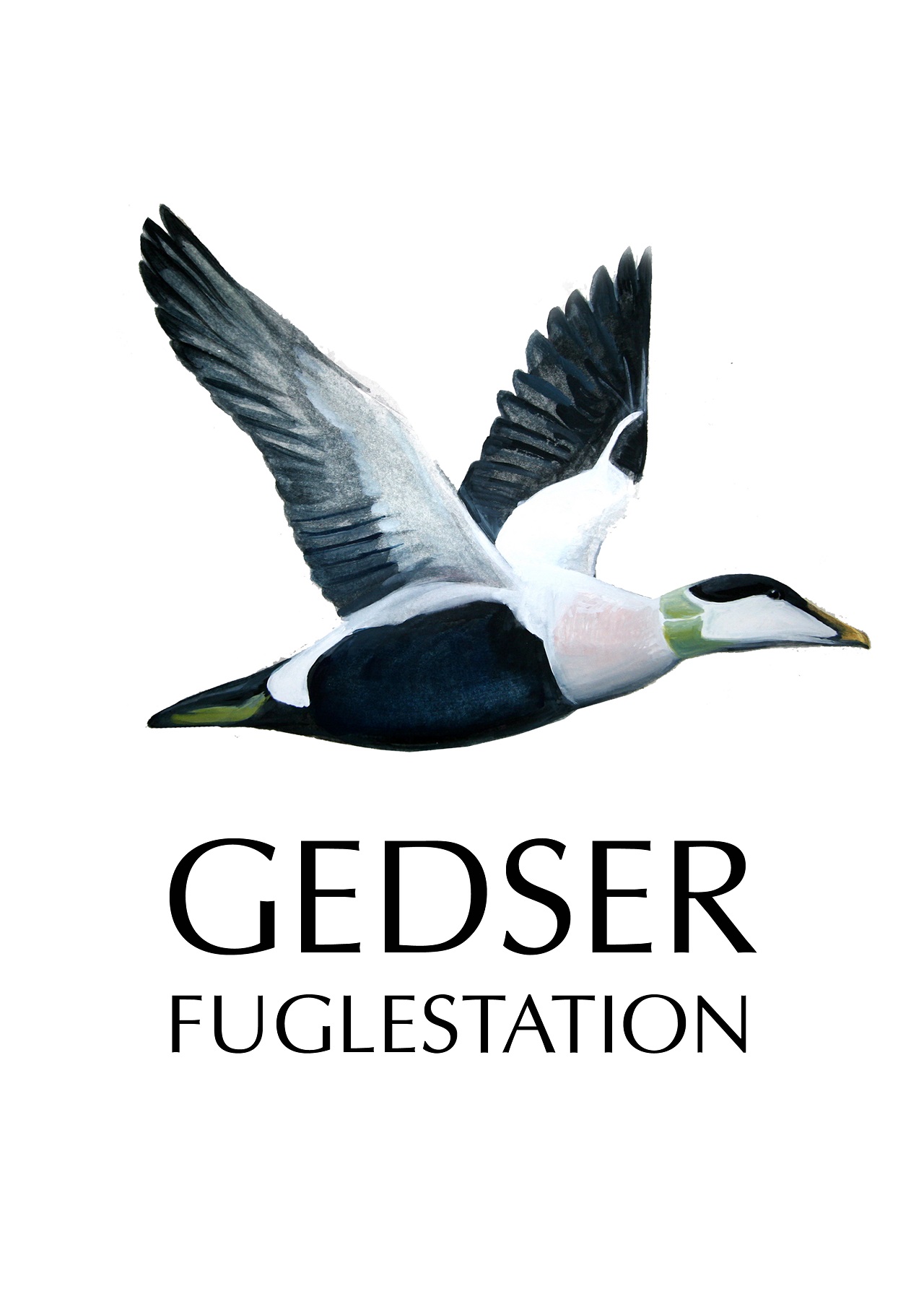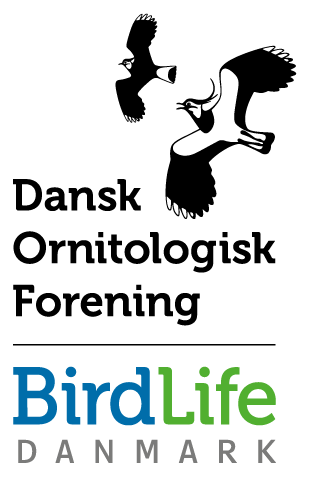Gedser Fuglestation Blog
Her på Gedser Fuglestations blog bringes korte nyheder i dagbogsformat om hændelser på fuglestationen.
Flot due i nettet - vi mangler folk til træktælling
Ringmærkningen: Marith havde en fridag så jeg måtte selv klare at sætte nettene op.
Heldigvis udeblev tågen og der var også både jernspurv og rødhalse at høre mens de sidste net kom op.
Det stilnede dog ret hurtigt af, så det var kun den første time jeg havde lidt at lave.
Dagens sjoveste fugl blev en ringdue som var gået i spurvehøgenettet(endnu en gang leverer det noget sjovt!). Ringdue bliver ikke ringmærket hver år, men det er fordi den er så stor at den nemt kan bakse sig ud af nettet. Ringdue er en stor fugl at have i hånden når man i den sidste 1,5 måned kun har haft op til drosselstørrelse. Denne ringdue vejede 485 gram.

På en normal standarddag(5 timer) går man ca 10.000 skridt, og det er også på dage hvor der er tomme net. Vi hører nogen gange folk sige at de ikke forstår at vi ofte er trætte om eftermiddagen da der ikke er fanget mere end en håndfuld fugle, men vi skal jo stadig tidligt op og sætte net op og gå vores runde hver halve time, så det er ikke unormalt at vi går ca 10km om dagen.
Dagen gav 32 fugle hvoraf de 24 var nye, så en del fugle er blevet i haven de sidste dage.
Dagens ringmærknig og kontroller/Todays ringing and recaptures:
Ringdue/Wood pigeon 1(0)
Gærdesmutte/Wren 0(2)
Jernspurv/Dunnock 6(0)
Rødhals/Robin 3(4)
Solsort/Blackbird 3(0)
Vindrossel/Redwing 1(0)
Gransanger/Chiffchaff 2(0)
Fuglekonge/Goldcrest 1(2)
Blåmejse/Blue tit 3(0)
Bogfinke/Chaffinch 3(0)
Grønirisk/Greenfinch 1(0)
Total 24(8)
Trækket på Odden: Et stort træk af Ederfugle (Somateria mollissima) er i gang. Onsdag blev det til tæt på 6.500 i løbet af de fem timer, vi kalder for standardtiden. Desværre mangler vi frivillige med erfaring i fugletræk og kunne ikke sende folk ud på Odden denne torsdag på grund af andre opgaver. Fredag ser det ud til at vi får dækket. Hen over weekenden går det også med egne folk, men fra onsdag 2. april mangler vi igen kyndige frivillige. Heldigvis ser det ud til, og vi i sidste øjeblik får en særdeles kompetent frivillig med erfaring i tælling på Gedser Odde til at dække en stor del af april.
Vi kunne godt bruge et par folk mere til at tælle og deltage i undervisning af nye træktællere. Interesserede må meget gerne begynde at tænke på efteråret, hvor vi i hvert fald en stor del af tiden vil have folk, som kan tælle og optræne nye instruktører/tællere.
Se alle dagens observationer fra Gedser Odde i DOFbasen.
Folk på stationen: Marith Mol, Henrik Jørgensen, Ole Friis Larsen.
Endnu en god fangstdag
Ringmærkningen: Vinden havde lagt sig lidt siden i går så alt blev åbnet.
De første 2 runder var der pænt med fugle, men der efter var der kun få pr runde. Dog var der kun en runde på dagen som var tom.
Dagen gav 38 fugle hvoraf de 36 var nye, så det var et godt antal.
Dagens topscorer blev igen jernspurv med 14, men også solsort var pæn med 7 stk.
I morgen loves dis/tåge så der må jeg se hvad det kan give.
Der kommer ikke noget fra træktælling i bloggen i dag da Ole havde møde efter tællingen, men han er tilbage.
Dagens ringmærkning og kontroller/Todays ringing and recaptures:
Gærdesmutte/Wren 2(0)
Jernspurv/Dunnock 14(0)
Rødhals/Robin 7(1)
Solsort/Blackbird 7(0)
Sangdrossel/Song thrush 2(0)
Gransanger/Chiffchaff 1(0)
Fuglekonge/Goldcrest 3(1)
Total 36(2)
På stationen: Marith Mol, Ole Friis Larsen, Henrik Jørgensen
Rygvind fik 4.500 Ederfugle til at lette
Ringmærkningen: Lidt uventet var der tåge,men også en smule vind så der var intet dug i nogen net.
I dag var Janus som kommmer fra en vildtplejestation og var med for at lære lidt om ringmærkning. Han er også med i morgen.
De første 2 runder havde pænt med fugle, hvor de fleste var jernspurve.
Dagen endte på 45 fugle hvoraf de 40 var nye fugle. Jernspurv udegjorde lige over halvdelen af dagens fangst med 21 ringmærkede.
I morgen loves lidt mindre vind med vind fra vestlig retning så det kan godt give en pæn bunke fugle igen.
Dagens ringmærkning og kontroller/Todays ringing and recaptures:
Gærdesmutte/Wren 1(1)
Jernspurv/Dunnock 21(0)
Rødhals/Robin 4(2)
Solsort/Blackbird 2(0)
Gransanger/Chiffchaff 5(0)
Fuglekonge/Goldcrest 2(1)
Rødtoppet fuglekonge/Firecrest 2(0)
Gråspurv/House sparrow 1(0)
Bogfinke/Chaffinch 0(1)
Grønirisk 1(0)
Gulspurv/Yellowhammer 1(0)
Total 40(5)
Trækket på Odden: En kold og fugtig morgen med tåge over havet og sigtbarhed helt ned til kun et par hundrede meter ind imellem, men vinden var drejet om i vest, og det gav rykvind til havtrækket ind i Østersøen. Ederfuglene (Somateria mollissima) var omgående på banen og kom i flokke på helt op til noget over hundrede af gangen. I løbet af standardtiden blev det til 4.470 af dem i et samlet træk på lidt over 5.000 fugle.
Det var hannerne, der havde travlt og dominerede. I en enkelt flok var der endda over 50 hanner helt uden hunner, i de fleste andre flokke dog 1-3 af de brune fugle. 3.500 af dagens Ederfugle kunne kønsbestemmes til 3.047 hanner og 453 hunner, en andel på bare 12,9 procent.
Det er på tide, at der kommer en periode med et større træk af Ederfugle. Vi har ikke nogen god dækning af forårstrækket ved Gedser Odde endnu, men sidste år havde vi en fin daglig dækning i marts, så 2024 og 2025 kan uden videre sammenlignes med hinanden. I marts 2024 registrerede vi 84.355 Ederfugle på træk mod nordøst. Indtil nu har vi i marts i år talt 31.365 Ederfugle – der mangler så at sige at komme over 50.000 Ederfugle forbi. Kan det mon nås i den uge, der er tilbage af måneden?
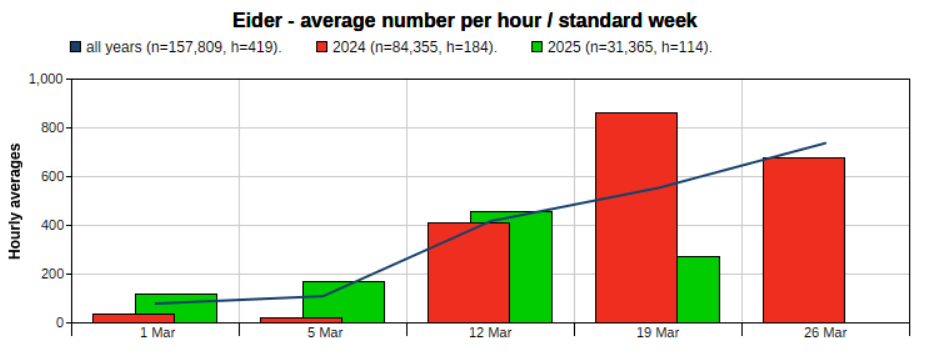 Grafikken fra den hollandske database Trektellen, som vi bruger parallelt med DOFbasen viser med grønne søjler, at trækket af Ederfugle i første halvdel af marts var større end sidste års røde søjler og tilmed lå over kurven for gennemsnittet over alle de år, vi har talt, men i den seneste uge har trækket af Ederfuglene så ligget langt under samme uge sidste år og gennemsnittet i det hele taget. Meget af det kan forklares med modvind fra østlige retninger og solskin, som næsten altid får andefugle til at blive, hvor de er.
Grafikken fra den hollandske database Trektellen, som vi bruger parallelt med DOFbasen viser med grønne søjler, at trækket af Ederfugle i første halvdel af marts var større end sidste års røde søjler og tilmed lå over kurven for gennemsnittet over alle de år, vi har talt, men i den seneste uge har trækket af Ederfuglene så ligget langt under samme uge sidste år og gennemsnittet i det hele taget. Meget af det kan forklares med modvind fra østlige retninger og solskin, som næsten altid får andefugle til at blive, hvor de er.
Dagens træk bød på 28 arter. Værd at bemærke var ud over Ederfuglene blandt andet en Rød Glente (Milvus milvus), som kom ind fra havet og fortsatte mod nord, hvor vi ellers i marts har set de få glenter trække ud mod syd. En flok på 122 Blisgæs (Anser albifrons) trak ud mod øst højt over Odden og i flot V-formation. De havde en lang rejse foran sig mod ynglepladserne i Nordsibirien. Dagens Splitterner (Thalasseus sandvicensis) trak ikke, men fløj rundt over havet og ledte efter mad. De raster formentlig på Rødsand vest for Gedser.
Se alle dagens observationer fra Gedser Odde i DOFbasen.
Folk på stationen: Marith Mol, Henrik Jørgensen, Ole Friis Larsen.
Godt arbejde fra lytteudstyr - Heggenmussen, goudhaantjes en winterkoninkjes!
De ringmarkering: Vandaag was een goede dag voor het ringen van de vogels! Vergeleken met gisteren is de wind gelukkig gaan liggen en was het ook bewolkt, wat goede omstandigheden zijn voor het vangen van vogels in de netten.
Met 9 verschillende soorten was er vandaag ook best wat soortendiversiteit. De meest gevangen vogelsoorten van vandaag zijn heggenmussen, goudhaantjes en winterkoninkjes. In totaal zijn er vandaag 42 nieuwe vogels geringd en waren er 3 recaptures.
Voor morgen ziet het weer er ook goed uit met niet veel wind en wat bewolking, hopelijk wordt morgen nog een goede dag voor het ringen!
Ringed (Recapture):
Wren 8(0)
Dunnock 13(0)
Robin 1(2)
Blackbird 1(0)
Song trush 1(0)
Chiffchaff 5(0)
Goldcrest 11(1)
Blue tit 1(0)
Brambling 1(0)
Total 42(3)
Trækket på Odden: Igen en morgen med vind fra nordøst og næsten ingen trafik af fugle i modvind. Det blev kun til 727 fugle fordelt på 27 arter med 227 Ederfugle (Somateria mollissima), som den mest talrige art.
Til gengæld i godt selskab med Bo Kayser og god snak om vores nye lytteudstyr og kunstig intelligens til genkendelse og registrering af fugle. På Odden har vi hver dag en såkaldt PUC tændt gennem de fem standardtimer. Lytteren kan ikke skelne mellem fugle, der holder fast til på landets sydspids, fugle, der raster i kort tid, og fugle, der flyver over på træk, men vi kan tjekke den kunstige intelligens’ pålidelighed i forhold til de arter, den registrerer. Hvor stor overensstemmelse er der mellem de arter, programmet registrerer og dem, som vi på en eller anden måde ser eller hører i løbet af de fem timer.
Denne morgen hørte PUC’en 950 kald af 22 arter af fugle. De 950 kald skal forstås som lyde fra fugle med intervaller på 9 sekunder. Hvis den samme fugl siger noget i mere end 9 sekunder, bliver det registreret som to eller flere kald. Dagens topscorer var en Jernspurv (Prunella modularis), som i timevis sang ivrigt fra toppen af en busk tæt på observationsposten. Den blev registreret 654 gange 9 sekunder svarende til 98 af de 300 minutter, tællingen varede. På anden pladsen kom de Sanglærker (Alauda arvensis), der var i området, med 121 registreringer, som omfattede både lokale syngende lærker og nogle med kald i flugten, når de trak ud eller forsøgte at trække ud over havet.
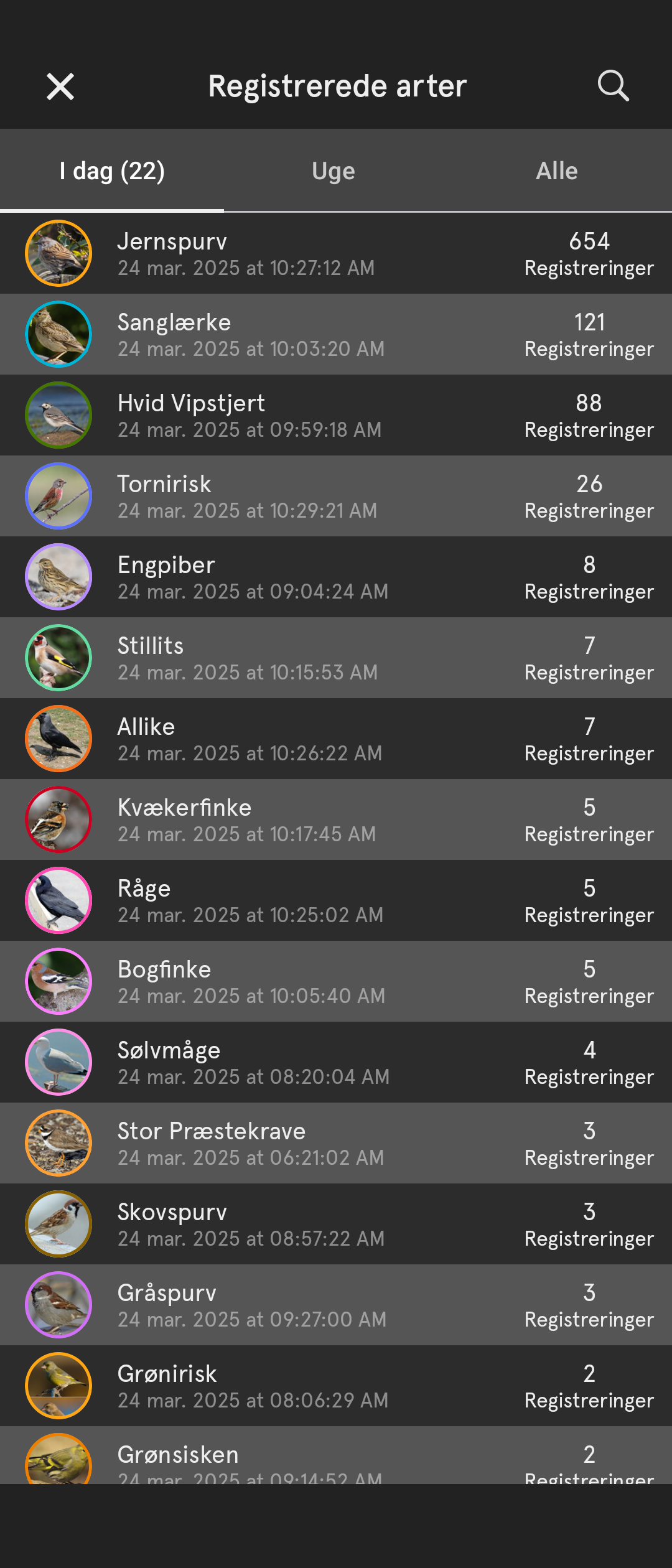 Skærmfoto af en del af dagens liste fra PUC'en på mobiltelefonen. I dag stemte alle arter yderst på Odden overens med vores menneskelige observationer - andre dage er der to-tre uoverensstemmelser, men selv det er ganske godt.
Skærmfoto af en del af dagens liste fra PUC'en på mobiltelefonen. I dag stemte alle arter yderst på Odden overens med vores menneskelige observationer - andre dage er der to-tre uoverensstemmelser, men selv det er ganske godt.
Det vigtigste var, at vi kunne nikke genkendende til, at vi selv havde hørt og/eller set samtlige 22 arter, som den kunstige intelligens i programmet BirdNet fra det amerikanske Cornell-universitet bød på med mindst 50 procent chance for, at det var den rigtige art helt ned til en enkelt registrering af henholdsvis Bramgås (Branta leucopsis), Gransanger (Phylloscopus collybita) , Solsort (Turdus merula) og Gærdesmutte (Troglodytes troglodytes). Det er ganske imponerende.
Hvis nogen vil se alle de 22 arter, vi registrerede – eller følge med online en anden dag – er det bare af finde #8620 - Ole Friis PUC-8620 – PUC på Gedser Odde på hjemmesiden BirdWeather. Den anden PUC på sydspidsen tilhører ringmærker Henrik Jørgensen, som har den tændt hver dag tæt på fuglestationens ringmærkningslaboratorium, mens han er på stationen. Så kan man direkte sammenligne forskelle på fuglelivet i haven og ude på spidsen.
Se alle dagens observationer fra Gedser Odde i DOFbasen.
Folk på stationen: Marith Mol, Henrik Jørgensen, Ole Friis Larsen.
Havedag
Ringmærkningen: Vinden var ikke helt så hård som i går så et par net mere kunne åbnes.
Fangsmæssigt blev det en ok dag med 9 fugle, dog var 6 af dem allerede ringmærket men det var forventet.
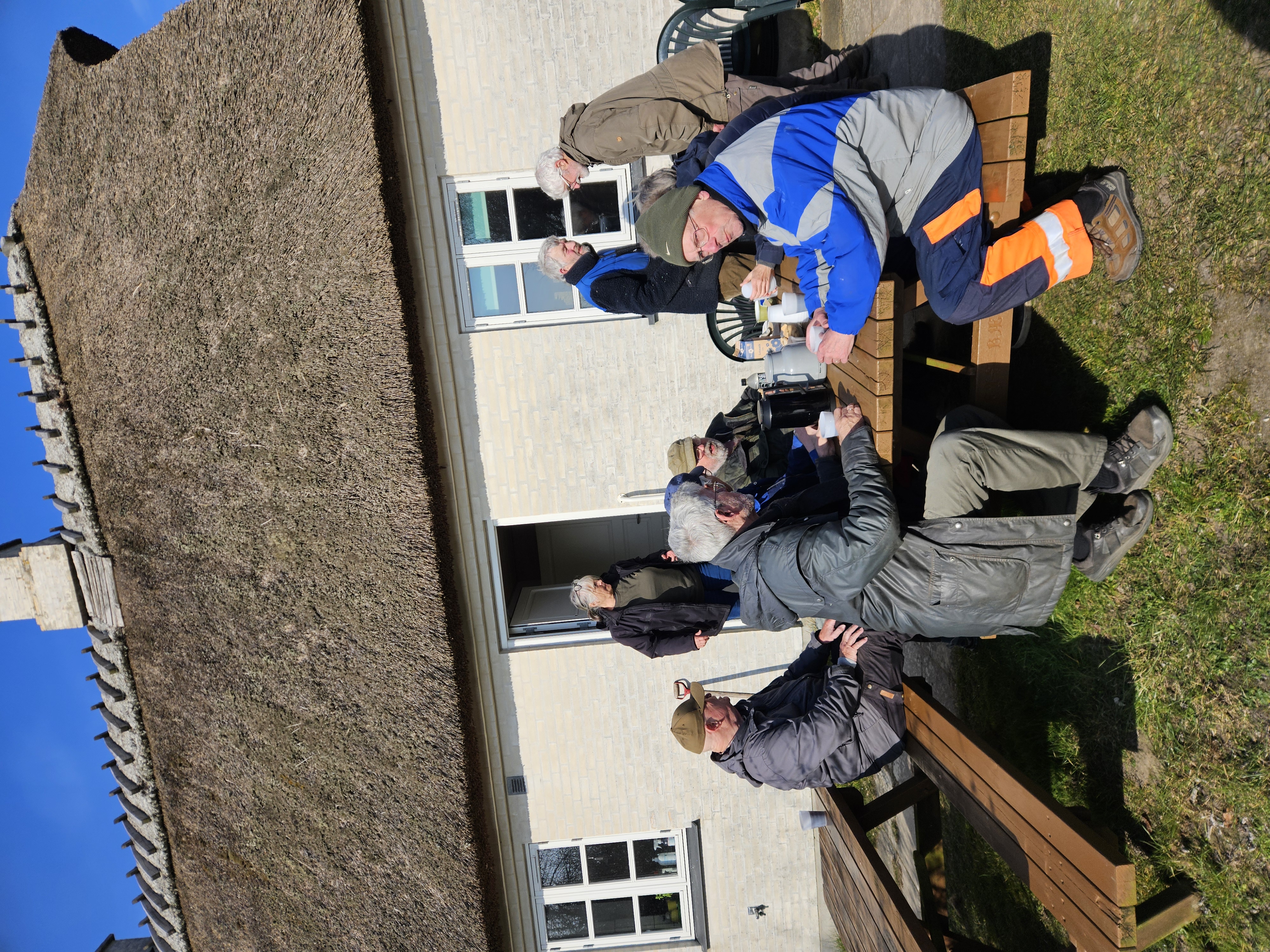
Efter nettene var lukket nåede vi lige at slappe af en lille times tid inden det var tid til havearbejde hvor en masse frivillige kom og hjalp til.
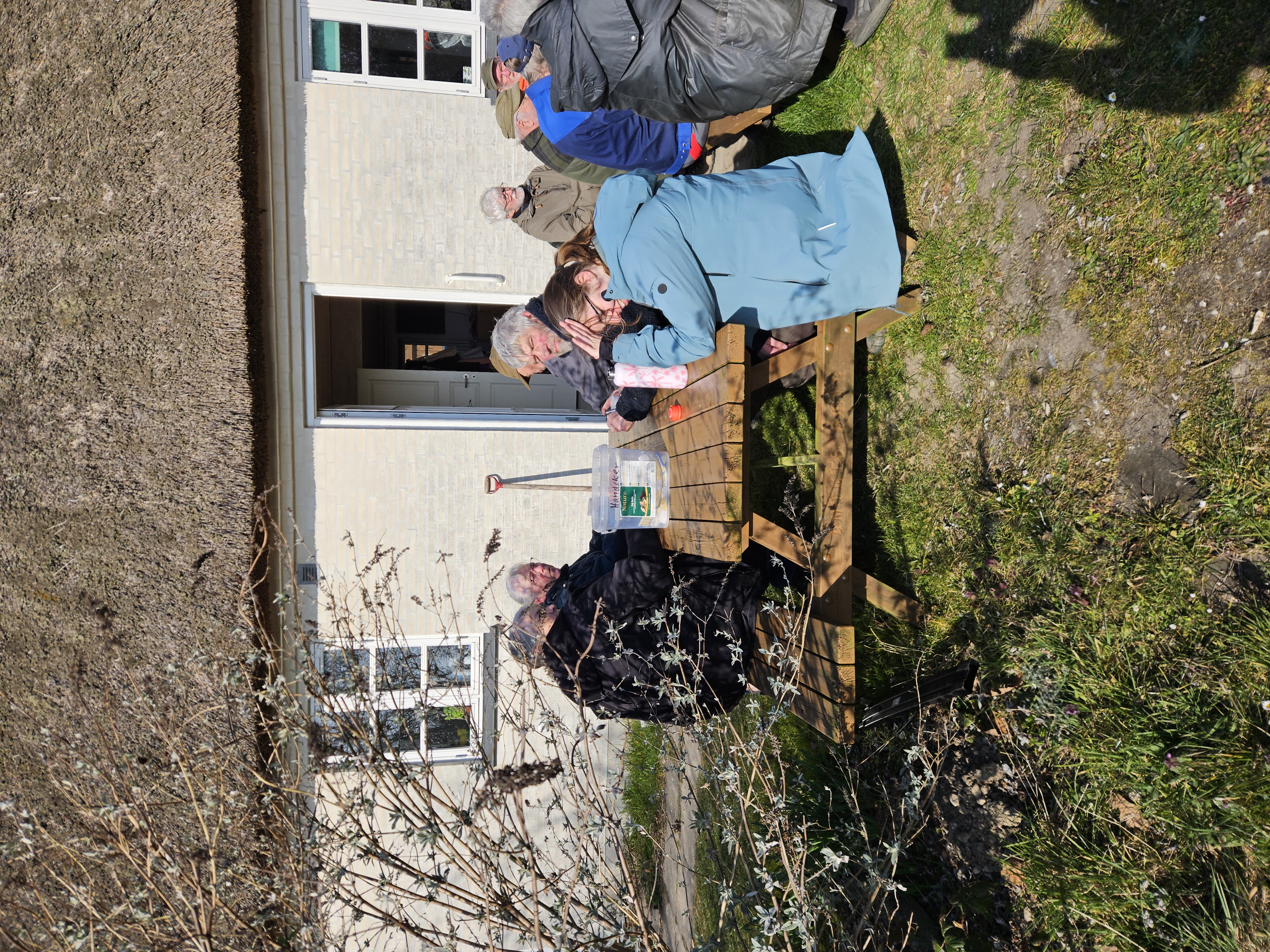
Vi fik nået langt mere end forventet, så det var super godt arbejdet af alle!
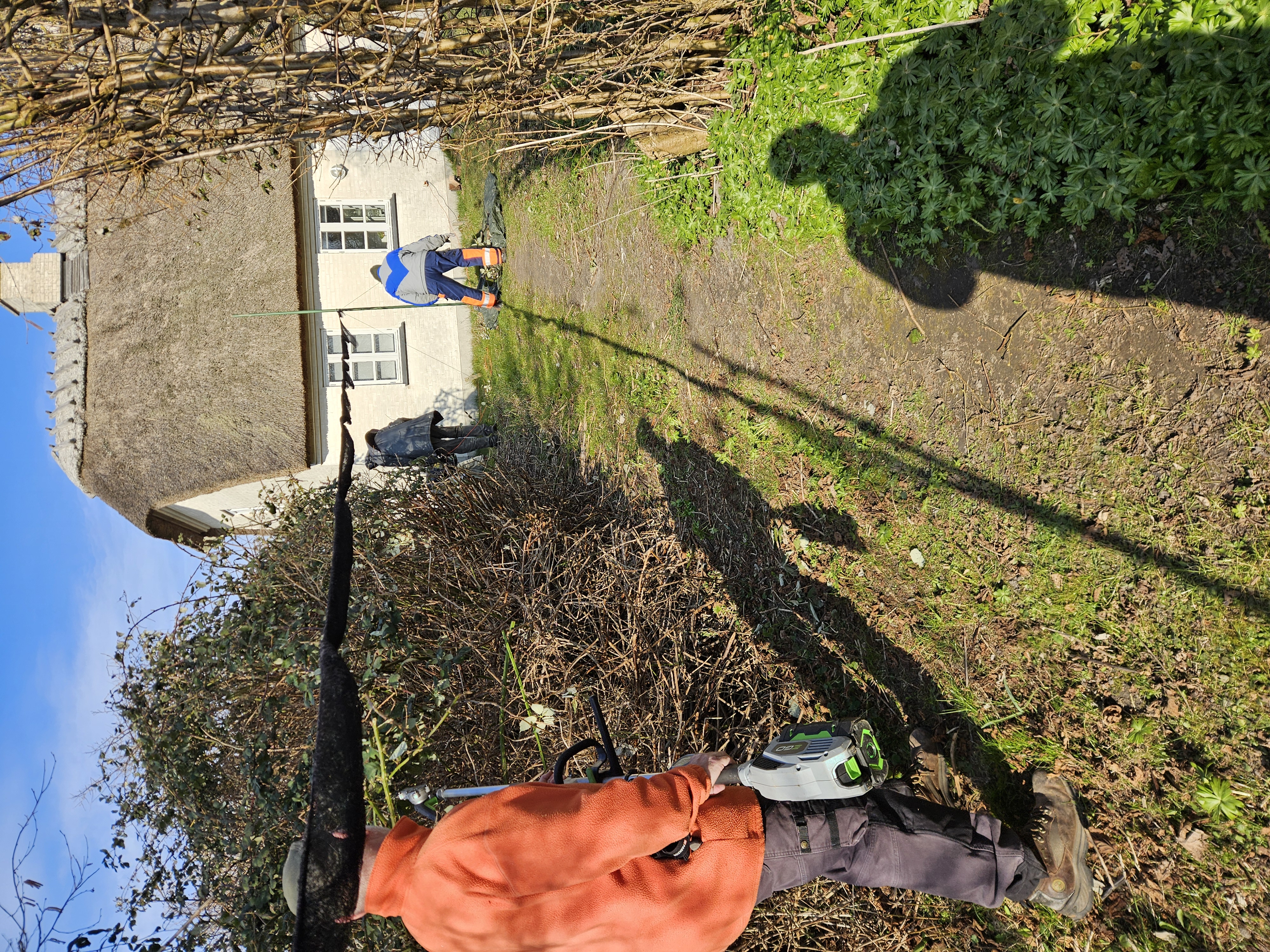
Stort tak til alle som kom i dag!
Da Ole havde gøremål i København, var der ingen træktælling i dag, men han er tilbage i aften.
Dagens ringmærkning og kontroller/todays ringing and recaptures
Gærdesmutte/Wren 1(1)
Jernspurv/Dunnock 1(0)
Rødhals/Robin 0(2)
Fuglekonge/Goldcrest 0(2)
Rødtoppet fuglekonge/Firecrest 0(1)
Bogfinke/Chaffinch 1(0)
Total 3(6)
På stationen: Ole Friis Larsen, Marith Mol, Hans Lind, Tina, Anne Marie, Gert + 14.
Duer på sydtræk
The ringing: Den hårde vind gjorde at vi ikke kunne sætte alle net op, men 107 netmeter gik lige at sætte op.
Vi regnede ikke med at fange meget og det gjorde vi heller ikke, men trods den hårde vind fangede vi 10 fugle hvoraf de 7 var nye fugle.
I morgen loves der også meget vind, så det vil nok mest give fugle vi har ringmærket i dag og i går.
Dagens ringmærkning og kontroller/Todays ringing and recaptures:
Gærdesmutte/Wren 3(1)
Rødhals/Robin 1(0)
Fuglekonge/Goldcrest 3(1)
Rødtoppet fuglekonge/Firecrest 0(1)
Total 7(3)
Trækket på Odden: Både fredag og lørdag var der tid til et par betragtninger over trækket ved Odden, som ikke nødvendigvis er rigtige, men dog baseret på observationerne. Fredag var der en del dis og i en periode direkte tåge lavt over havet og land; Månen var klar og fin at se højt på himmelen, mens det ikke var muligt at se færgehavnen i Gedser nogle få kilometer væk. Alligevel var der en del fugle på træk, som altså ikke kunne se, hvor de fløj hen.
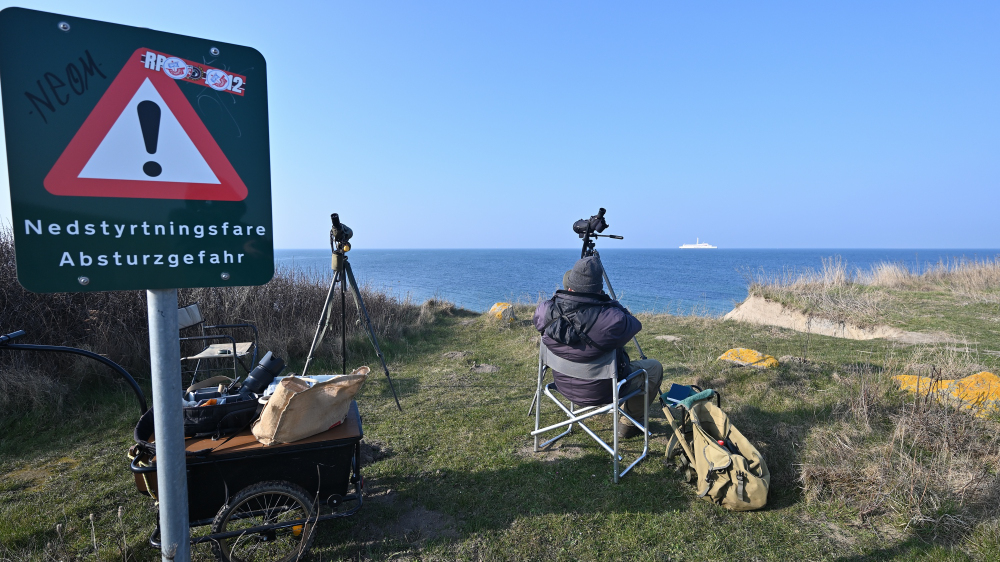
Lørdag var der en relativt hård vind fra øst på 9-11 meter i sekundet, og der var ikke ret meget trafik over havet på modvindsruterne mod øst og nordøst, mens de få duer, småfugle og en enkelt Rød Glente (Milvus milvus), der havde sidevind eller ligefrem en slags rygvind skråt bagfra på sydlige og sydvestlige kurser fra land mod Tyskland uden videre trak ud i blæsten.
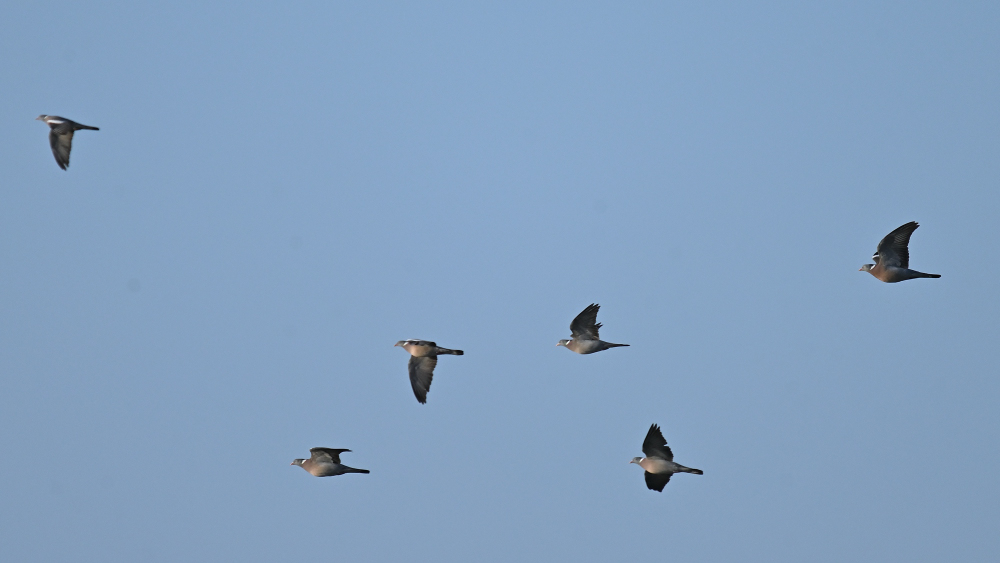
Fredag var der over 2.600 fugle af 35 arter, som trodsede tåge og dis på trækruterne ved Odden. Lørdag var knap 500 fugle af 21 arter ude i blæsten; kun 218 Ederfugle (Somateria mollissima) passerede Odden i modvinden, mens endnu flere landede til rast mellem de hundredvis af Ederfugle, der i forvejen rastede på havet mellem Rødsand og Gedser Odde. Med andre ord lignede det en pausedag i trækket. På samme dato talte vi sidste år 5.900 Ederfugle på træk forbi Odden, så det er ikke, fordi det ikke er på tide for dem at komme af sted.
Se alle dagens observationer fra Gedser Odde i DOFbasen.
Folk på stationen: Marith Mol, Henrik Jørgensen, Ole Friis Larsen.
Pænt antal ringmærket
Ringmærkningen: Der var svag vind og lidt diset da vi satte nettene op og allerede der kunne vi høre flere jernspurve kalde.
Første runde gav over 10 fugle, og der var ikke en eneste runde i dag uden fugle. Dog var der til sidst en del genfangster af især fuglekongerne.
En halemejse med ring som jeg ikke mente var herfra blev tastet ind senere i vores database viste at den var ringmærket af Benny i Marielyst 1 juledag 2024, så den var nu endt ca 4-5km længere sydpå.

Langt de fleste fugle i dag var fuglekonger, men også 3 gransanger og 8 rødhals blev ringmærket så nu er der ved at kome gang i forårstrækket!
Dagen endte med 60 ringmærket og 4 kontroller, og det er et ganske pænt antal for marts.
I morgen loves der hård vind fra øst, så ikke den bedste for fangst.
Der kommer ingen blog i dag fra træktællingen da Ole er til møde i København, han er dog tilbage sent i aften så i morgen kommer der blog derfra igen.
Dagens ringmærkning og kontroller/Todays ringing and recaptures:
Gærdesmutte/Wren 2(0)
Jernspurv/Dunnock 10(0)
Rødhals/Robin 8(2)
Sangdrossel/Song Thrush 1(0)
Gransanger/Chiffchaff 3(0)
Fuglekonge/Goldcrest 35(1)
Rødtoppet fuglekonge/Firecrest 1(0)
Halemejse/Long-tailed tit 0(1)
Total 60(4)
På stationen: Marith Mol, Ole Friis Larsen, Henrik Jørgensen
Gransangerne er kommet
The ringing: Today was a very good day of ringing, with the most birds in standard time for march this year. The first round started with already ten birds and more followed. Today also the first starling and chiffchaff were captured and several new goldcrests, wrens and a firecrest arrived.
Ringed and recapture:
Wren 5(0)
Dunnock 5(0)
Robin 2(1)
Blackbird 2(0)
Chiffchaff 1(0)
Goldcrest 1(1)
Firecrest 1(1)
Starling 1(0)
Bullfinch 1(0)
Total: 19(3)
Trækket på Odden: Der var rimfrost på bilen, borde og bænke i haven omkring stationen, og det knasede af frost i græsset på turen ud til ugens hidtil flotteste solopgang. Temperaturen kom hurtigt op, og der var næsten ingen vind. En skøn morgen at observere i, men hvordan med trækket i det fortsat gode vejr og nu uden vind?
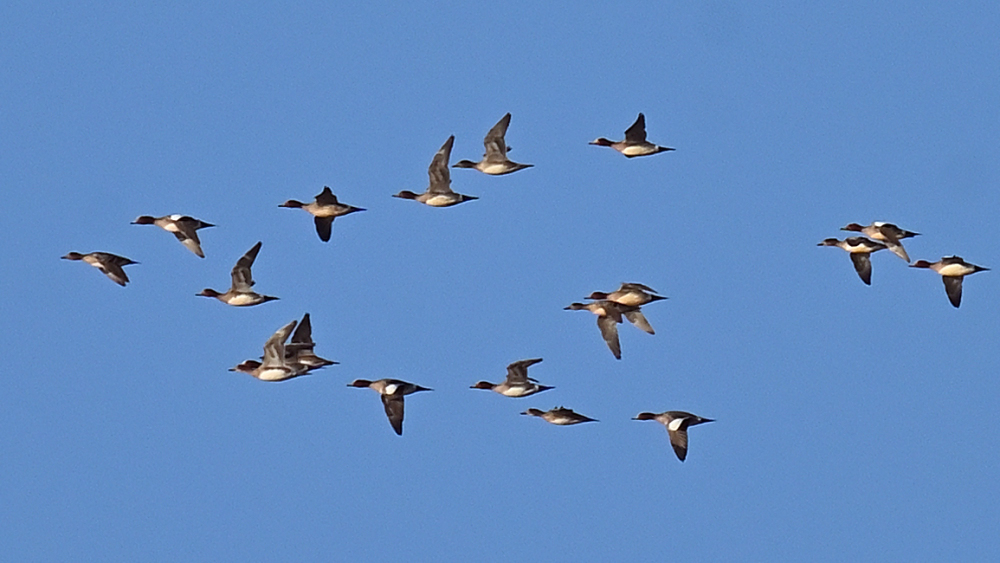
Der kom ikke noget stort træk, men der var mere variation end i de seneste foregående dage, først og fremmest med næsten 400 Pibeænder (Mareca penelope) i den østlige trafik ind i Østersøen. Et svagt træk af Ederfugle (Somateria mollissima) endte på lige under 500 fugle, og andelen af hunner var hele nede på 19,1 procent.
Samlet set lige omkring 1.450 fugle fordelt på 26 arter.
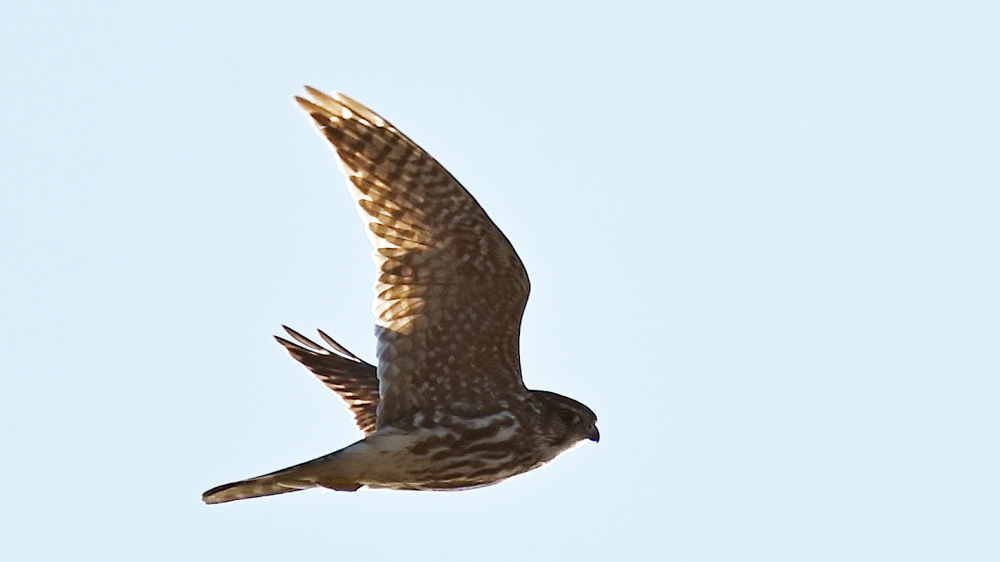
En udtrækkende Dværgfalk (Falco columbarius) mod syd var en fin oplevelse.
To Gransangere (Phylloscopus collybita) var årets første på Gedser Odde. De var allerede før solopgang i fuld gang med at fylde maverne og var ikke i ro et øjeblik, mens de tavse hoppede rundt fra gren til gren i søgen efter insekter i det levende hegn på den yderste spids. Der kom ikke en lyd fra dem, så de var sikkert akkurat nået frem i løbet af natten og enormt sultne efter turen over havet. Et tip ind til ringmærkerne gav et svar om, at de også havde fanget og ringmærket en Gransanger.
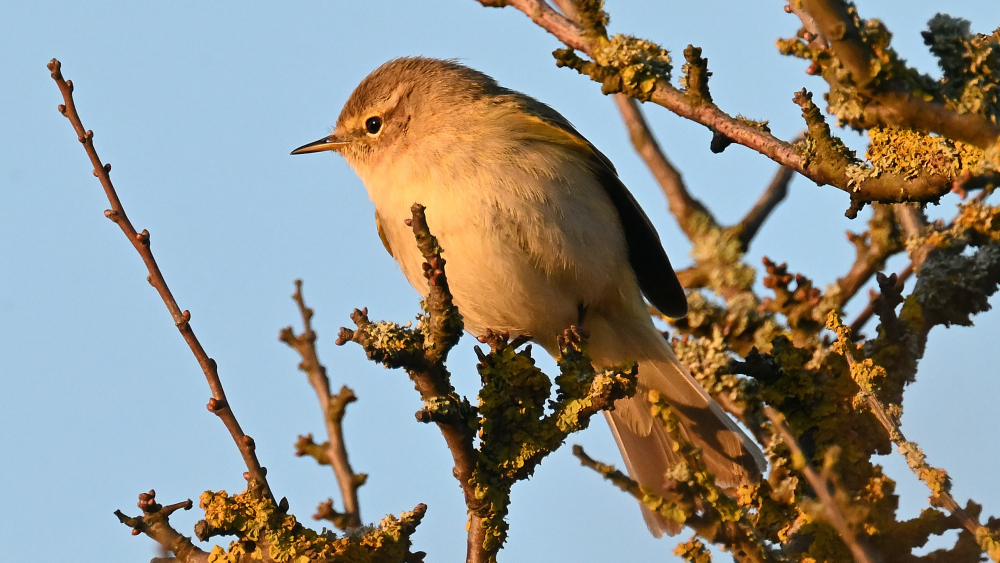
Se alle dagens observationer fra Gedser Odde i DOFbasen.
Folk på stationen: Marith Mol, Henrik Jørgensen, Ole Friis Larsen.
God variation af arter i fangsten
Ringmærkningen: I dag var jeg alene om ringmærkningen da Marith havde en velfortjent fridag.
Vejret var solrigt hele dagen men der var frost de fleste steder i haven den første time.
På trods af det flotte men kolde vejr var der en del fugle i haven og 16 fugle blev fanget hvoraf de 14 var nye. Det var en god fordeling på 9 arter og det er ikke dårligt på denne tid af året.
Årets første bogfinke blev også ringmærket i dag.
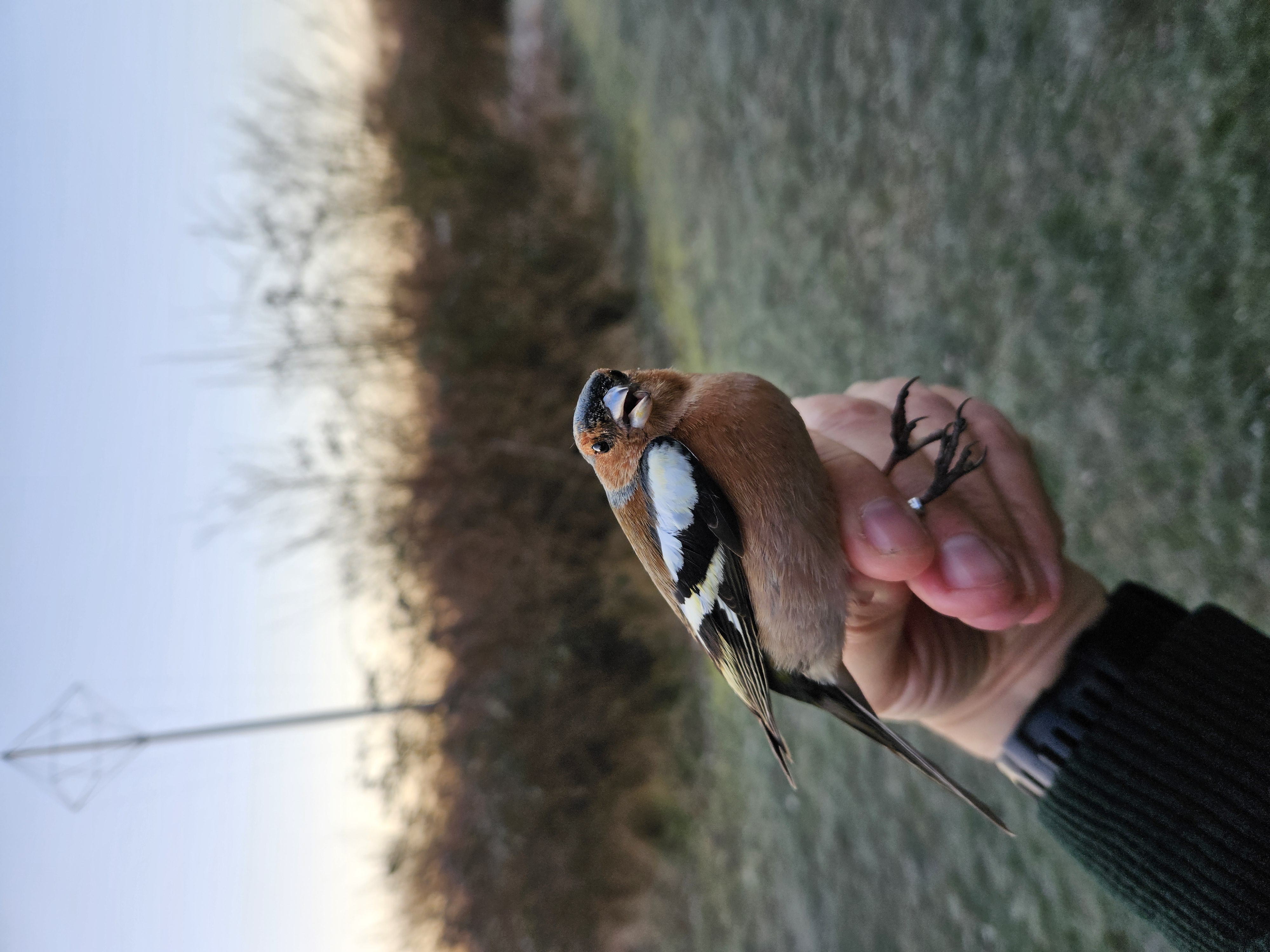
Vejret i morgen er af samme skuffe, men vinden går i syd-øst og det er ikke den bedste retning for fangsten da de fleste fugle kommer fra syd-vest.
Dagens ringmærkning og kontroller/Todays ringing and recaptures:
Jernspurv/Dunnock 2(0)
Rødhals/Robin 1(0)
Solsort/Blackbird 1(1)
Sangdrossel/Song thrush 1(0)
Fuglekonge/Goldcrest 3(0)
Blåmejse/Blue tit 3(1)
Træløber/Treecreeper 1(0)
Bogfinke/Chaffinch 1(0)
Grønirisk/Green finch 1(0)
Total 14(2)
Trækket på Odden: Endnu en smuk morgen med flot solopgang og efterhånden lidt varme i luften efter nattefrosten, der knasede i græsset på vejen ud til spidsen. Vinden var i vest som tirsdag, men noget svagere. Der rastede stadig flere hundrede Ederfugle (Somateria mollissima) og andre andefugle på havet, men der var åbenbart ikke nogen særlig trang til at komme videre, og kun få lettede i solskinnet for at trække. Det gav små tal i dagens tælling.
Lidt over 1.600 fugle fordelt på 23 arter. Af dem var 1.200 Ederfugle, som næsten alle kom længere væk fra i den forstand, at de fleste kom i lidt større grupper noget efter solopgang og dukkede op i teleskopet på vestsiden af færgehavnen i Gedser.
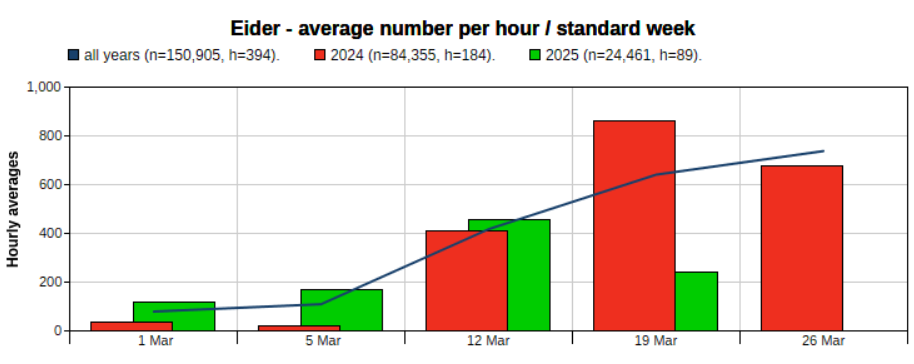
Grafikken viser trækket af Ederfugle ved Gedser Odde i marts. Kurven er gennemsnittet for flere år, de røde søjler viser trækkets intensitet i standardtiden i 2024 og de grønne søjler i år. Trækket var lidt over gennemsnit og større end i 2024 i begyndelsen af måneden, men er til gengæld foreløbig noget lavere i denne uge. Grafik: Trektellen.
Se alle dagens observationer fra Gedser Odde i DOFbasen.
Nyt fra stationen: Vi mangler stadig en træktæller til april og en del af maj til at tælle og undervise en ung, som kommer i april og maj. Han skal ringmærke hver anden uge og arbejde med træktælling de andre uger. Skriv til kontakt@gedserfuglestation.dk eller ring eventuelt til Ole Friis Larsen på +4540918071
Folk på stationen: Marith Mol, Henrik Jørgensen, Ole Friis Larsen.
Ederfuglene flyver som vinden blæser
The ringing: Today was a day with very few ringed birds. Probably the circumstances were not as good today for catching birds in the nets because of a strong wind from west and much sun. Today there were more recaptures than newly ringed birds with 3 recaptures and two newly ringed birds.
Dunnock 2(0)
Blackbird 0(1)
Goldcrest 0(1)
Great tit 0(1)
Total 2(3)
Trækket på Odden: Tirsdag lignede mandag til forveksling med en enkelt stor forskel. Mandag kom vinden fra fra nordøst, tirsdag kom den fra vest, og det gav mange flere fugle, men næsten kun af en enkelt art. Omkring solopgang lettede rastende Ederfugle (Somateria mollissima) fra havet ud for Odden i hundredvis, og senere kom der en del flokke længere vestfra, før stort set hele trafikken stoppede, og der ikke var meget at tælle den sidste halvanden time.
Forskellen på vinden fra nordøst og fra vest var i konkrete tal 1.100 fugle, hvoraf 500 var Ederfugle, mandag og tirsdag 4.150 fugle på træk, hvoraf 3.850 var Ederfugle. Det strammer selvfølgelig til hver dag for Ederfuglene at komme af sted mod ynglelokaliteterne i Østersøen, men fra dag til dag kan vejrforholdene betyde ganske meget.
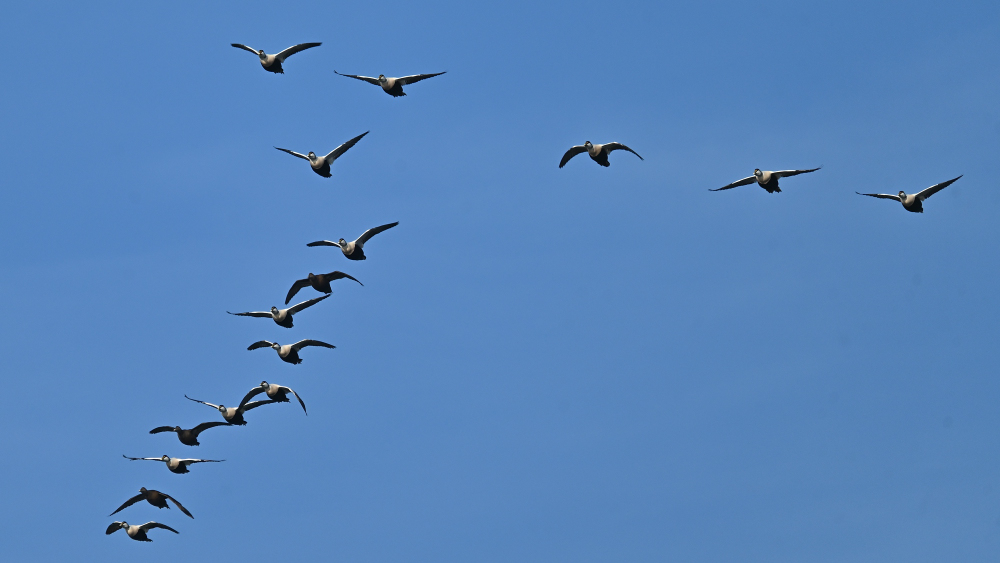
De 3.850 Ederfugle var samtidig dette års største antal af den art i vores daglige fem timers standardtid. Antallet af hunner var lavt med kun 22,8 procent af det køn.
Se alle dagens observationer fra Gedser Odde i DOFbasen.
Folk på stationen: Marith Mol, Henrik Jørgensen, Ole Friis Larsen.
